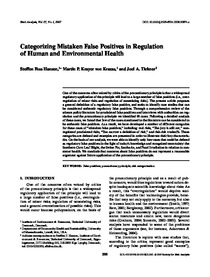Categorizing mistaken false positives in regulation of human and environmental health

Hansen, Steffen F. ; Krayer von Krauss, Martin P. ; Tickner, Joel A.
2007
27
255-269
cancer ; exposure assessment ; precautionary principle ; regulation ; risk assessment
Risk assessment and risk management
English
Bibliogr.
"One of the concerns often voiced by critics of the precautionary principle is that a widespread regulatory application of the principle will lead to a large number of false positives (i.e., overregulation of minor risks and regulation of nonexisting risks). The present article proposes a general definition of a regulatory false positive, and seeks to identify case studies that can be considered authentic regulatory false positives. Through a comprehensive review of the science policy literature for proclaimed false positives and interviews with authorities on regulation and the precautionary principle we identified 88 cases. Following a detailed analysis of these cases, we found that few of the cases mentioned in the literature can be considered to be authentic false positives. As a result, we have developed a number of different categories for these cases of "mistaken false positives," including: real risks, "The jury is still out," nonregulated proclaimed risks, "Too narrow a definition of risk," and risk-risk tradeoffs. These categories are defined and examples are presented in order to illustrate their key characteristics. On the basis of our analysis, we were able to identify only four cases that could be defined as regulatory false positives in the light of today's knowledge and recognized uncertainty: the Southern Corn Leaf Blight, the Swine Flu, Saccharin, and Food Irradiation in relation to consumer health. We conclude that concerns about false positives do not represent a reasonable argument against future application of the precautionary principle."
Digital
The ETUI is co-funded by the European Union. Views and opinions expressed are however those of the author(s) only and do not necessarily reflect those of the European Union or the ETUI.